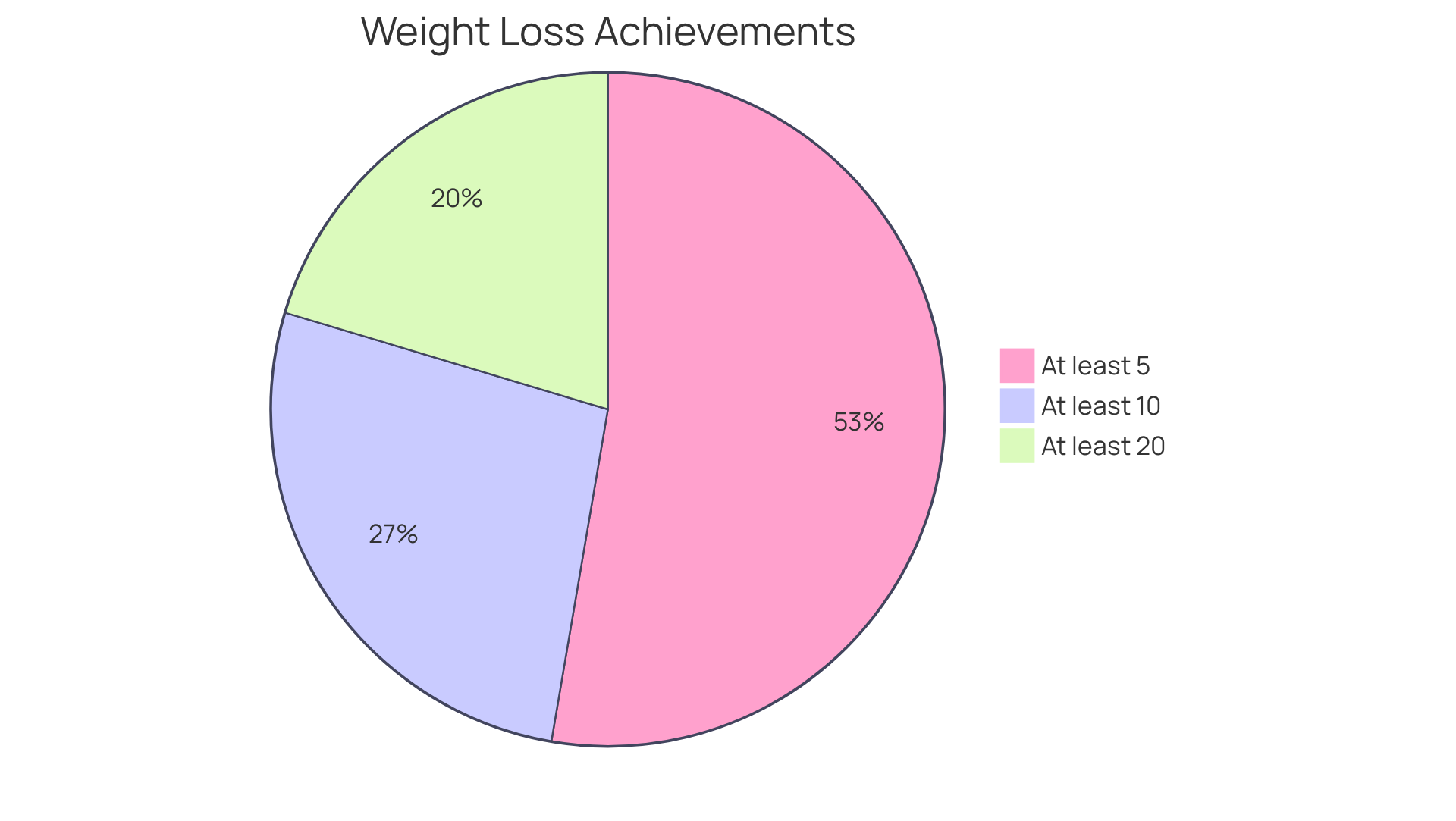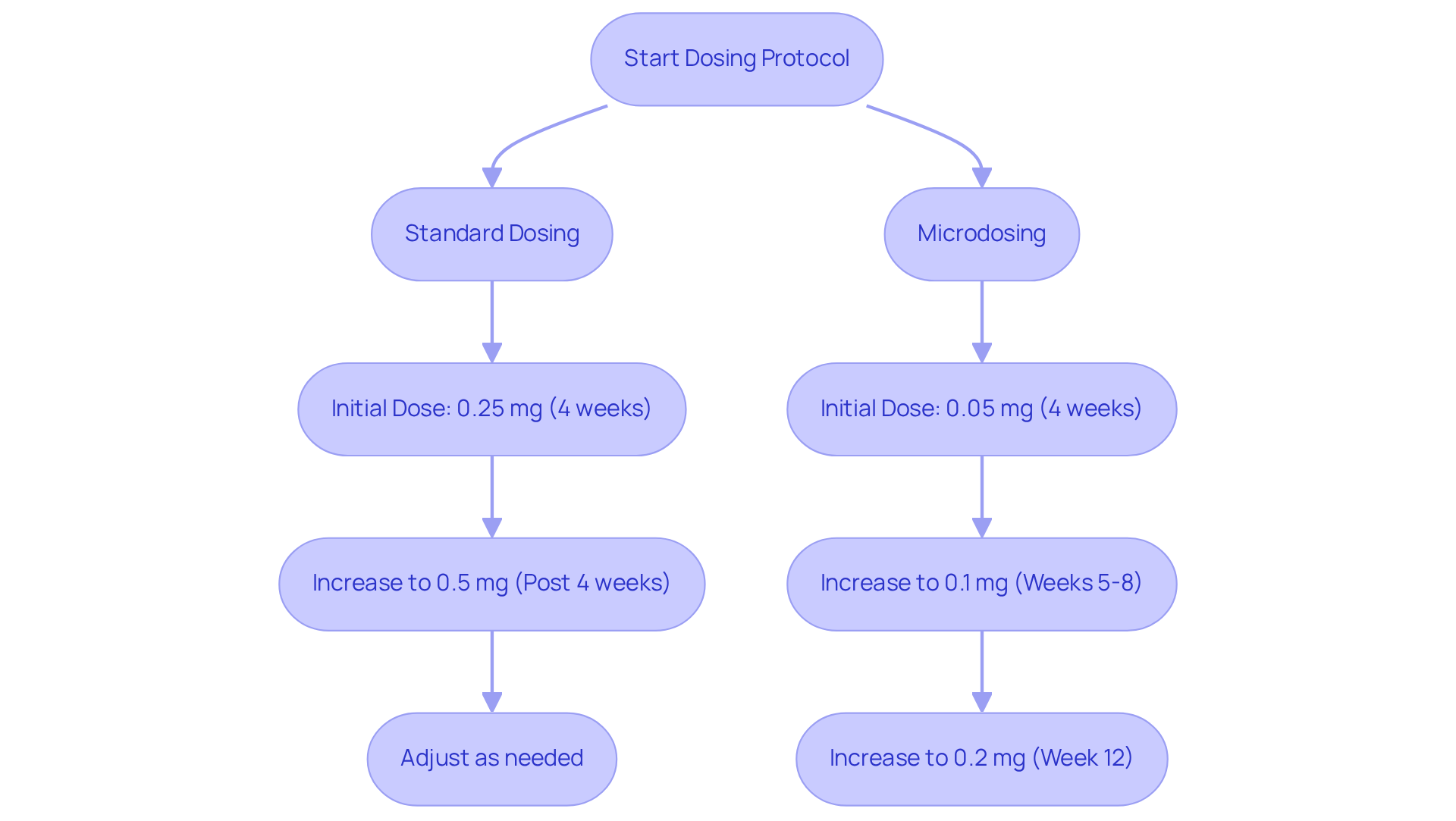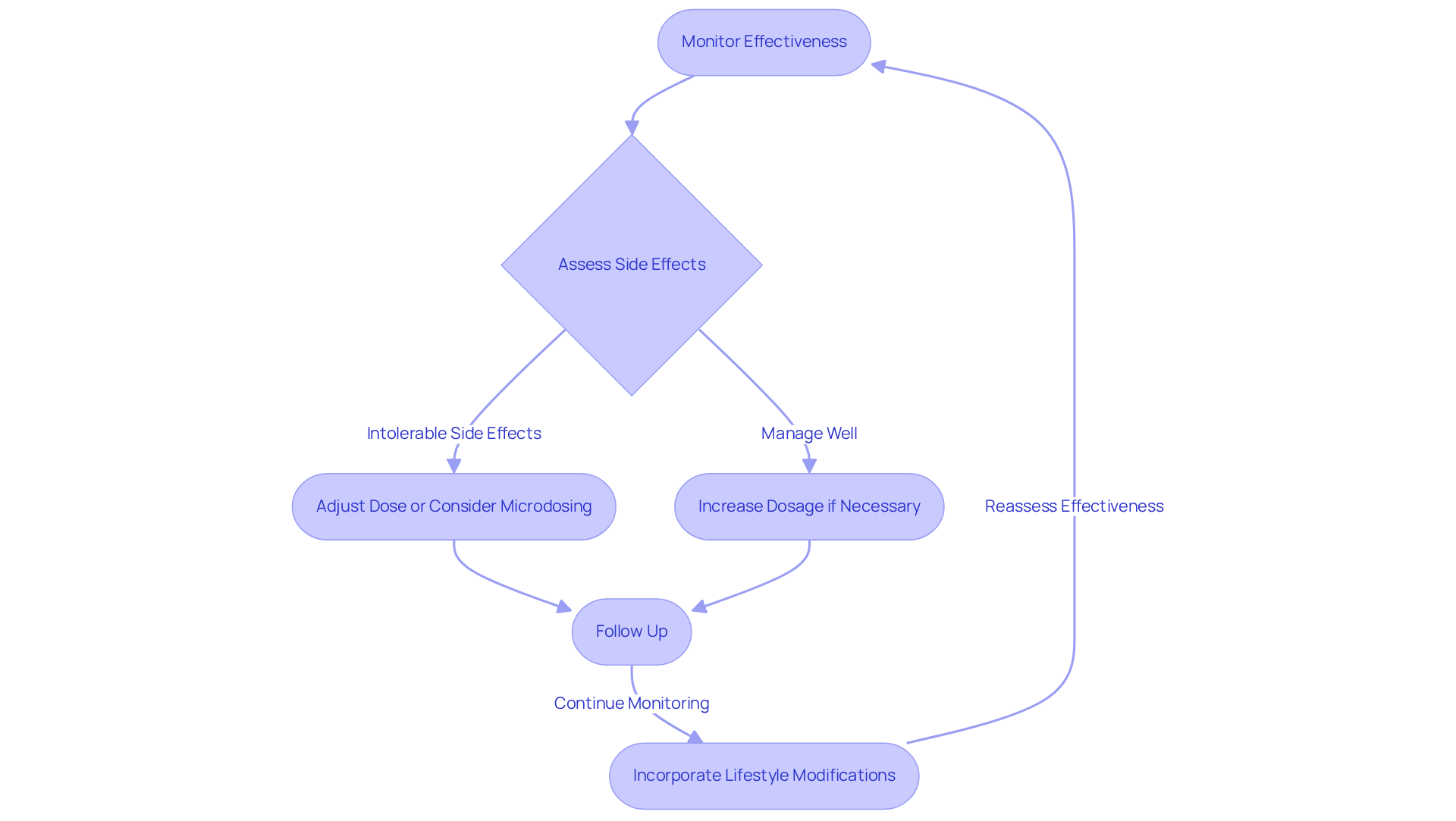Overview
Navigating the journey of weight loss can feel overwhelming, especially for those facing obesity and type 2 diabetes. Semaglutide peptide dosing offers a tailored strategy to enhance its effectiveness, with dosages adjusted based on personal tolerance and response. This personalized approach is crucial, as it includes both standard and microdosing protocols designed to minimize side effects and improve adherence.
Have you ever felt discouraged by the challenges of managing your weight? You’re not alone. Many patients have experienced significant weight loss outcomes through these personalized strategies. By focusing on what works best for you, we can help you achieve your goals together.
Remember, this journey is not just about medication; it’s about finding a path that feels right for you. We’re here for you, offering support and guidance every step of the way. Together, we can celebrate your successes and navigate any obstacles that arise. Your health and well-being are our top priorities.
Introduction
Semaglutide has emerged as a groundbreaking treatment for obesity and type 2 diabetes, offering a unique mechanism as a GLP-1 receptor agonist that enhances insulin secretion and curbs appetite.
We understand that embarking on a weight loss journey can feel overwhelming, and this article delves into the intricacies of semaglutide peptide dosing.
Here, we offer tailored strategies designed to maximize its effectiveness while minimizing potential side effects.
As you take this important step toward better health, a critical question arises: how can you navigate the complexities of dosing protocols to achieve the best results while ensuring your safety?
Together, we can explore these solutions and support you on your journey.
Understand Semaglutide: Mechanism and Uses
Semaglutide is a glucagon-like peptide-1 (GLP-1) receptor agonist that mimics the effects of the GLP-1 hormone, released in the gut in response to food intake. This medication enhances insulin secretion, reduces glucagon release, and slows gastric emptying. Together, these actions lower blood sugar levels and promote feelings of fullness. This mechanism not only assists in glycemic control but also significantly helps with body mass loss by suppressing appetite and caloric consumption.
For those facing challenges with obesity and type 2 diabetes, semaglutide peptide dosing provides a flexible solution. Clinical studies reveal that participants experienced an average decrease of 14.9% in body mass, compared to only 2.6% in the placebo group over extended durations. Remarkably, 86.4% of participants achieved at least a 5% reduction in mass, while 44.2% reached a 10% reduction after two years. This highlights the effectiveness of this treatment in promoting healthier body composition and overall well-being.
Additionally, 33.4% of participants treated with semaglutide lost at least 20% of their baseline weight, showcasing its potential for significant weight loss. It’s important to remember that while semaglutide is effective, it works best when combined with lifestyle changes, such as a balanced diet and regular physical activity. Have you considered how these changes could complement your journey?
Patients should also be mindful of possible gastrointestinal reactions, particularly nausea, which affects 20-30% of users. The average duration of semaglutide peptide dosing is typically between 12 to 18 months, providing a timeline for those considering this treatment. Remember, together, we can achieve your goals, and support is available every step of the way.
Establish Dosing Protocols: Standard and Microdosing Strategies
Starting a new medication can feel overwhelming, and we want to support you every step of the way. The standard protocol for semaglutide peptide dosing begins with an initial dose of 0.25 mg once weekly for the first four weeks. This gradual introduction allows you to adjust to the medication while minimizing common gastrointestinal reactions that may occur during the initial treatment phase.
After this initial period, the dose is typically increased to 0.5 mg weekly, with further adjustments made based on how you respond and how well you tolerate the medication. If you find yourself experiencing considerable reactions or prefer a more gradual approach, microdosing techniques can be especially beneficial. Microdosing involves administering smaller doses than the standard protocol, which can enhance your comfort and adherence to the treatment plan.
For example:
- Starting with 0.05 mg weekly for the first four weeks
- Increasing to 0.1 mg weekly for weeks 5-8
- Then to 0.2 mg weekly by week 12
This can effectively reduce side effects while allowing for a personalized treatment plan. This customized approach not only promotes adherence but also supports sustained fat loss and better glycemic control, aligning with our holistic care philosophy that emphasizes long-term health outcomes.
It’s important to remember that the maximum therapeutic semaglutide peptide dosing can reach up to 2.4 mg weekly. Additionally, stopping the medication may lead to rebound weight gain, which highlights the necessity of following the dosing protocol. Together, we can achieve your goals and navigate this journey toward better health.
Monitor and Adjust: Tailoring Doses for Individual Needs
Regular monitoring of individuals on semaglutide is essential to evaluate how well the medication is working and to make necessary adjustments to the dosing regimen. We understand that this journey can be overwhelming, and that’s why healthcare professionals should arrange follow-up consultations to assess your progress, any side effects, and your overall health.
If you experience intolerable side effects, it may be necessary to lower the dose or consider a microdosing strategy. But if you find that you’re managing the medication well yet not achieving the desired weight loss, don’t worry—gradually increasing the dosage could be the key.
This personalized approach ensures that you receive the most effective treatment while minimizing risks. Remember, you’re not alone in this journey. Incorporating lifestyle modifications such as a balanced diet and regular exercise can further enhance the effectiveness of semaglutide and support your long-term weight management goals.
Together, we can achieve your goals, and every small step counts towards your success. How can you start making those changes today?
Recognize Side Effects: Safety Considerations and Management
If you’re experiencing typical adverse reactions from semaglutide, such as nausea, vomiting, or diarrhea, know that you’re not alone. These gastrointestinal issues are often temporary and may improve as your body adjusts to the medication. To help ease these symptoms, consider making some dietary changes. Eating bland foods and staying well-hydrated can make a big difference. Have you thought about trying smaller, more frequent meals? This approach can often alleviate discomfort and make your experience more manageable.
However, if these reactions persist or worsen, it’s important to communicate with your healthcare provider. Together, you can explore options like adjusting your semaglutide peptide dosing schedule or considering alternative therapies. Remember, open dialogue is key to addressing your concerns and ensuring a positive treatment experience.
It’s also crucial to be aware of the possibility of more serious side effects, such as pancreatitis or kidney injury. If you experience severe abdominal pain or notice changes in urination, please seek medical attention right away. We’re here for you, and together, we can navigate this journey toward better health.
Conclusion
Semaglutide marks a meaningful step forward in managing obesity and type 2 diabetes, providing a valuable resource for those seeking better health. By mimicking the GLP-1 hormone, this medication not only helps with glycemic control but also promotes significant weight loss when paired with lifestyle changes. Tailored dosing strategies, whether through standard protocols or microdosing, allow patients to find a regimen that suits their unique needs and comfort levels.
Throughout this article, we’ve shared crucial insights about how semaglutide works, effective dosing strategies, and the importance of monitoring and adjusting treatment plans to achieve the best outcomes. The potential for substantial weight loss, highlighted by clinical studies, showcases semaglutide’s effectiveness in fostering a healthier body composition. Moreover, understanding and managing side effects is vital for ensuring patient comfort and adherence to the treatment plan.
Ultimately, your journey toward improved health with semaglutide is a collaborative effort that thrives on ongoing communication and support. As you consider this treatment, we encourage you to embrace lifestyle changes that can enhance its effectiveness. Taking proactive steps today can lead to meaningful changes tomorrow, reinforcing the belief that with the right tools and guidance, achieving your health goals is within reach. Remember, we’re here for you, and together, we can achieve your goals.
Frequently Asked Questions
What is semaglutide and how does it work?
Semaglutide is a glucagon-like peptide-1 (GLP-1) receptor agonist that mimics the effects of the GLP-1 hormone. It enhances insulin secretion, reduces glucagon release, and slows gastric emptying, which lowers blood sugar levels and promotes feelings of fullness.
What are the primary uses of semaglutide?
Semaglutide is primarily used for glycemic control in individuals with type 2 diabetes and for assisting with weight loss in those facing challenges with obesity.
How effective is semaglutide for weight loss?
Clinical studies show that participants experienced an average decrease of 14.9% in body mass with semaglutide, compared to only 2.6% in the placebo group. Additionally, 86.4% of participants achieved at least a 5% reduction in mass, and 44.2% reached a 10% reduction after two years.
What percentage of participants lost significant weight while using semaglutide?
About 33.4% of participants treated with semaglutide lost at least 20% of their baseline weight.
How long is the typical duration for semaglutide peptide dosing?
The average duration of semaglutide peptide dosing is typically between 12 to 18 months.
Are there any side effects associated with semaglutide?
Yes, patients may experience gastrointestinal reactions, particularly nausea, which affects 20-30% of users.
How can semaglutide treatment be optimized for better results?
Semaglutide works best when combined with lifestyle changes, such as a balanced diet and regular physical activity.





















